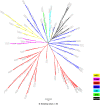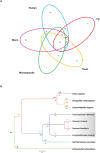Genome-wide identification and comprehensive analyses of the kinomes in four pathogenic microsporidia species
- PMID: 25549259
- PMCID: PMC4280135
- DOI: 10.1371/journal.pone.0115890
Genome-wide identification and comprehensive analyses of the kinomes in four pathogenic microsporidia species
Abstract
Microsporidia have attracted considerable attention because they infect a wide range of hosts, from invertebrates to vertebrates, and cause serious human diseases and major economic losses in the livestock industry. There are no prospective drugs to counteract this pathogen. Eukaryotic protein kinases (ePKs) play a central role in regulating many essential cellular processes and are therefore potential drug targets. In this study, a comprehensive summary and comparative analysis of the protein kinases in four microsporidia—Enterocytozoon bieneusi, Encephalitozoon cuniculi, Nosema bombycis and Nosema ceranae—was performed. The results show that there are 34 ePKs and 4 atypical protein kinases (aPKs) in E. bieneusi, 29 ePKs and 6 aPKs in E. cuniculi, 41 ePKs and 5 aPKs in N. bombycis, and 27 ePKs and 4 aPKs in N. ceranae. These data support the previous conclusion that the microsporidian kinome is the smallest eukaryotic kinome. Microsporidian kinomes contain only serine-threonine kinases and do not contain receptor-like and tyrosine kinases. Many of the kinases related to nutrient and energy signaling and the stress response have been lost in microsporidian kinomes. However, cell cycle-, development- and growth-related kinases, which are important to parasites, are well conserved. This reduction of the microsporidian kinome is in good agreement with genome compaction, but kinome density is negatively correlated with proteome size. Furthermore, the protein kinases in each microsporidian genome are under strong purifying selection pressure. No remarkable differences in kinase family classification, domain features, gain and/or loss, and selective pressure were observed in these four species. Although microsporidia adapt to different host types, the coevolution of microsporidia and their hosts was not clearly reflected in the protein kinases. Overall, this study enriches and updates the microsporidian protein kinase database and may provide valuable information and candidate targets for the design of treatments for pathogenic diseases.
Conflict of interest statement
Figures







Similar articles
-
The complement of protein kinases of the microsporidium Encephalitozoon cuniculi in relation to those of Saccharomyces cerevisiae and Schizosaccharomyces pombe.BMC Genomics. 2007 Sep 4;8:309. doi: 10.1186/1471-2164-8-309. BMC Genomics. 2007. PMID: 17784954 Free PMC article.
-
Comparative Analysis of Codon Usage Bias Patterns in Microsporidian Genomes.PLoS One. 2015 Jun 9;10(6):e0129223. doi: 10.1371/journal.pone.0129223. eCollection 2015. PLoS One. 2015. PMID: 26057384 Free PMC article.
-
[Animal reservoirs of human virulent microsporidian species].Wiad Parazytol. 2009;55(1):63-5. Wiad Parazytol. 2009. PMID: 19579789 Polish.
-
[Encephalitozoon cuniculi and Encephalitozoon intestinalis--causes of opportunistic infections].Epidemiol Mikrobiol Imunol. 2002 Feb;51(1):26-32. Epidemiol Mikrobiol Imunol. 2002. PMID: 11881297 Review. Czech.
-
Microsporidia: emerging pathogenic protists.Acta Trop. 2001 Feb 23;78(2):89-102. doi: 10.1016/s0001-706x(00)00178-9. Acta Trop. 2001. PMID: 11230819 Review.
Cited by
-
Identification and Characterization of Bacillus cereus SW7-1 in Bombyx mori (Lepidoptera: Bombycidae).J Insect Sci. 2015 Sep 27;15(1):136. doi: 10.1093/jisesa/iev121. Print 2015. J Insect Sci. 2015. PMID: 26411789 Free PMC article.
-
Host-Parasite Interactions and Purifying Selection in a Microsporidian Parasite of Honey Bees.PLoS One. 2016 Feb 3;11(2):e0147549. doi: 10.1371/journal.pone.0147549. eCollection 2016. PLoS One. 2016. PMID: 26840596 Free PMC article.
-
Kinome Expansion in the Fusarium oxysporum Species Complex Driven by Accessory Chromosomes.mSphere. 2018 Jun 13;3(3):e00231-18. doi: 10.1128/mSphere.00231-18. Print 2018 Jun 27. mSphere. 2018. PMID: 29898984 Free PMC article.
-
The Kinome of Pacific Oyster Crassostrea gigas, Its Expression during Development and in Response to Environmental Factors.PLoS One. 2016 May 27;11(5):e0155435. doi: 10.1371/journal.pone.0155435. eCollection 2016. PLoS One. 2016. PMID: 27231950 Free PMC article.
-
Towards discovery of new leishmanicidal scaffolds able to inhibit Leishmania GSK-3.J Enzyme Inhib Med Chem. 2020 Dec;35(1):199-210. doi: 10.1080/14756366.2019.1693704. J Enzyme Inhib Med Chem. 2020. PMID: 31752556 Free PMC article.
References
-
- Bhat SA, Bashir I, Kamili AS (2009) Microsporidiosis of silkworm, Bombyx mori L.(Lepidoptera-Bombycidae): a review. Afr J Agric Res 4:1519–1523.
-
- Chen Y, Evans JD, Smith IB, Pettis JS (2008) Nosema ceranae is a long-present and wide-spread microsporidian infection of the European honey bee (Apis mellifera) in the United States. Journal of Invertebrate Pathology 97:186–188. - PubMed
-
- Cox-Foster DL, Conlan S, Holmes EC, Palacios G, Evans JD, et al. (2007) A metagenomic survey of microbes in honey bee colony collapse disorder. Science 318:283–287. - PubMed
-
- Higes M, Martín-Hernández R, Botías C, Bailón EG, González-Porto AV, et al. (2008) How natural infection by Nosema ceranae causes honeybee colony collapse. Environmental Microbiology 10:2659–2669. - PubMed
Publication types
MeSH terms
Substances
LinkOut - more resources
Full Text Sources
Other Literature Sources

